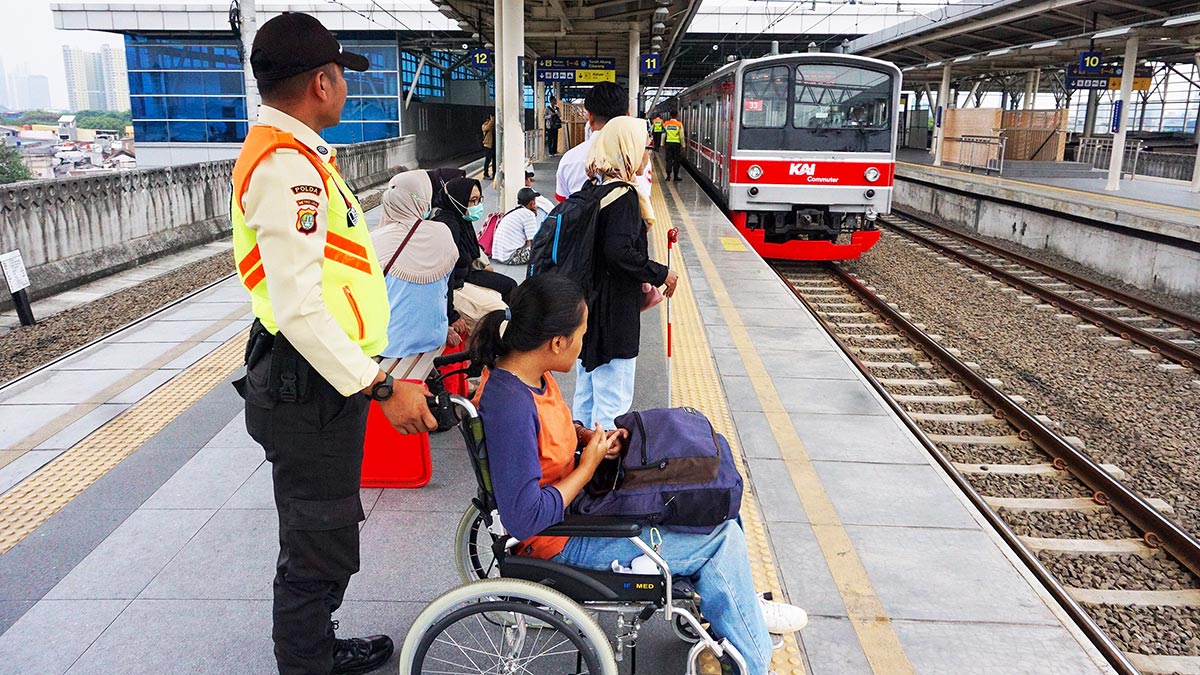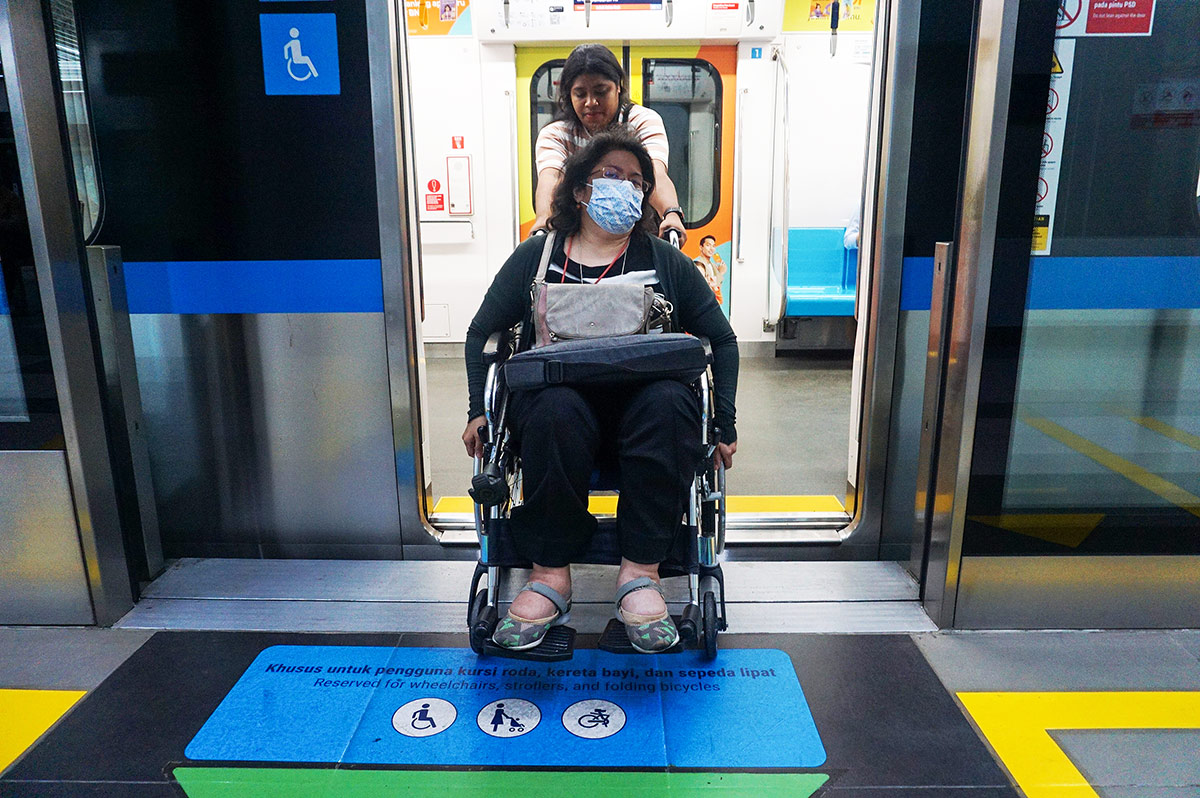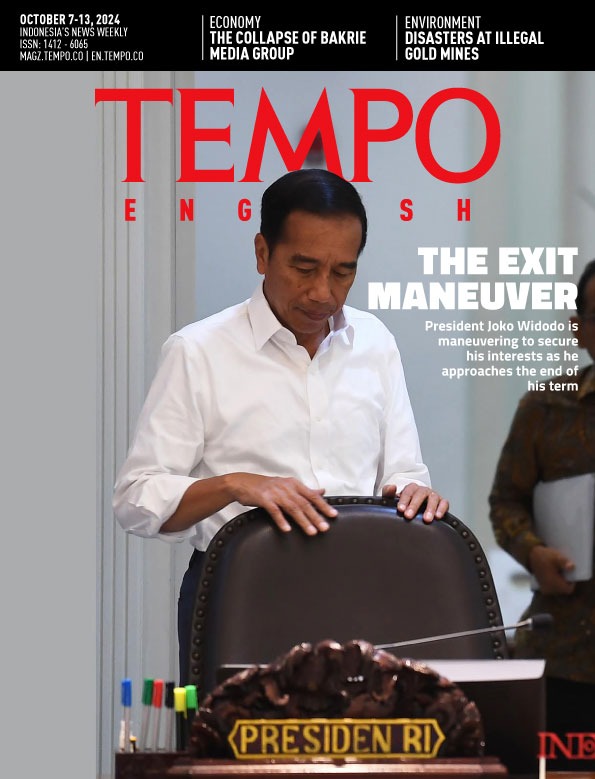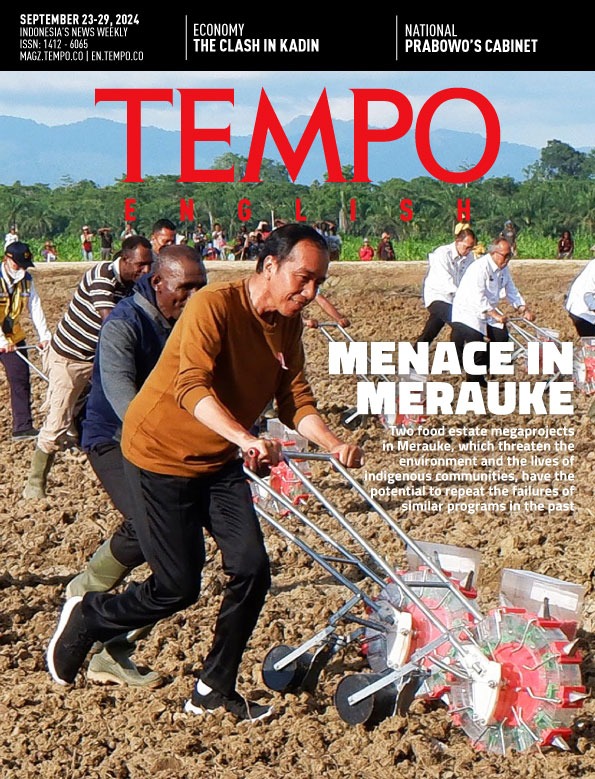Holes in Disability-Friendly Transportation in Jakarta
Monday, October 14, 2024
Despite some improvements, much still needs to be done regarding access to public transport for people with disabilities in Jakarta.
arsip tempo : 172888651089.

WITH her white cane in hand, Nadia Lestari, 26, carefully made her way into Bogor Station on Saturday, September 28, 2024. She had traveled by online taxi, which she ordered from her house in Tegallega, Central Bogor, West Java.
Before she reached the tap-in machine at the station, a security officer named Sugianto approached her. Wearing a bright yellow vest, he helped Nadia tap her e-money card on the machine.
Sugianto asked which station she was traveling to and guided her to the correct platform, with Nadia holding onto his arm.
Luckily, a Commuter Line (KRL) train was already at the platform that morning. Sugianto seated Nadia in a priority seat in the second coach from the back.
After helping her, Sugianto reported to a station and KRL staff WhatsApp group, alerting them that a passenger with disabilities was on board. “There will also be an officer to assist at the destination station,” explained Sugianto.
Nadia often travels by KRL and other public transport in Jakarta. That day, she was heading for Juanda Station. Nadia, whose eyesight began to deteriorate drastically in high school, had arranged to meet a friend near Pecenongan and Pasar Baru in Central Jakarta.
Nadia feels fortunate to live near Bogor Station, which she feels is friendly to people with disabilities because she does not need to go up and down flights of steps, and the station entrance is quite close to the platform. “Most importantly, the staff are always helpful,” Nadia said.
Nadia, who works for a non-governmental organization, also praised Juanda Station, noting that its elevators and escalators make it accessible for people with disabilities.

An officer helps a person with disabilities disembark from Transjakarta Cares at the National Library, Jakarta, August 2023. TEMPO/Tony Hartawan
On Monday, September 30, 57 kilometers north of Bogor, Herlina walked slowly using a three-legged cane toward Cakra Selaras Wahana (CSW) in Blok M, South Jakarta. The 46-year-old woman has struggled with her left knee and ankle since an accident seven years ago.
Herlina was heading to an elevator to the 5th floor of CSW to catch a Transjakarta bus on Corridor 13 (CBD Ciledug-Tegal Mampang). She had just finished meeting friends at a restaurant in M Bloc Space. Herlina decided to travel by Transjakarta bus for the trip from Ciledug in Tangerang, Banten, to Blok M and back.
“Luckily, the two stops I use (CBD Ciledug and CSW Blok M) are quite accessible for people with special needs, like me,” said Herlina, who works as a reseller on an online marketplace.
Despite this, she remains cautious when boarding the bus, as the gap between the platform and the bus door is sometimes more than 30 centimeters, compelling her to ask for help from the staff. “It’s a big problem if there aren’t enough staff at the bus stops,” she noted.
Disability-friendly transportation services are an important issue in Jakarta’s upcoming gubernatorial election. Gubernatorial candidate Pramono Anung has emphasized the need for better access to public transport for people with disabilities. Meanwhile, candidate number 1 on the ballot, Ridwan Kamil, has promised to empower more pramusapa, special assistants on Transjakarta, across all public transport facilities to improve accessibility for people with disabilities. Dharma Pongrekun-Kun Wardana Abyoto’s campaign head, Siti Fadilah Supari, has also promised to enhance facilities for people with disabilities in public spaces and transportation, including improving access to Transjakarta buses.
Access to Transjakarta buses is a major concern for people with disabilities. Epi, a blind commuter, points out the dangers posed by the gap between the platform and Transjakarta buses. Despite this, he is grateful that staff members are always available to assist him when boarding or disembarking.
However, many Transjakarta bus stops and KRL stations have difficult access for Epi and other people with disabilities. One major issue is the pedestrian bridges leading to these stops or stations, which often require the use of steps that are either too narrow or too steep. Epi mentioned that these steps pose a significant challenge for people with disabilities.
“Especially metal steps that seem damaged or have holes. It’s best to avoid them,” said Epi, a massage therapist.
Epi also cited Pasar Senen and Kampung Bandan stations as examples where passengers must climb numerous steps to access or move between platforms. The many steps at these KRL stations present significant obstacles for people with disabilities.
Therefore, Epi chooses Transjakarta bus stops or KRL stations that have ramps. He frequently uses Cempaka Putih and PGC stations as examples of accessible stops.
Several Transjakarta stops feature pelican crossings, including those on Jalan Medan Merdeka Selatan, Jalan M.H. Thamrin, and parts of Jalan Jenderal Sudirman in Central Jakarta. According to Epi, access to these one-level stations and stops is very easy for individuals with visual disabilities like him, as well as for others with disabilities.
Epi also praised the Mass Rapid Transit (MRT) and Light Rail Transit (LRT) stations for providing assistance to people with disabilities. Although access varies at different levels, both transport providers have installed elevators and escalators to enhance accessibility. “And there are many staff that provide assistance on the trains,” he said.
Interestingly, Epi, Herlina, and Nadia avoid using JakLingko. Many JakLingko drivers lack experience serving people with disabilities, and Epi and his friends have encountered drivers who are aggressive or impatient. “It’s better to use online taxis,” Epi said.
Muharyati, Chair of the Indonesian Association of Women with Disabilities (HWDI) in Jakarta, emphasized the need for improvements to JakLingko. Despite its convenience in covering narrow streets across the city, the behavior of some drivers remains a problem. “Some drivers are rude, especially the older ones. They get angry when they have to assist passengers with disabilities or the elderly,” Muharyati told Tempo on October 5.
She also highlighted the issue of obstructed tactile paving on sidewalks in several areas of Jakarta. For instance, some sections have been turned into parking spaces for motorbikes and cars or occupied by street vendors. She expressed regret that the Jakarta government’s good intentions in installing tactile paving to assist people with disabilities have ultimately failed to serve their purpose.

Nadia (49), a passenger with disabilities, is accompanied by her assistant at the HI Roundabout MRT station, Jakarta, September 24, 2024. TEMPO/Ilham Balindra
Muharyati hopes that the Jakarta government will continue to improve transportation services for people with disabilities, from facilities to more friendly staff. “We need more staff and dedicated elevators for people with disabilities because others tend to use the current ones,” she said.
Deliani Poetriayu Siregar, Urban Planning and Inclusivity Manager at the Institute for Transportation Development Policy Indonesia, highlighted other issues, such as pedestrian bridges with uneven or damaged surfaces. She noted that while free Transjakarta and Mikrotrans travel cards are available for people with disabilities, they are not accompanied by adequate accessibility measures.
Deliani also pointed out the lack of services for people with hearing disabilities. While the physical characteristics of deaf individuals may be less visible, they require specialized visual communication assistance.
Unfortunately, when people with hearing disabilities travel on the KRL, they often have difficulty understanding which station they are passing or whether the doors on the left or right will open. Deliani noted that information about the next station on KRL trains is typically provided through static posters. Since announcements are usually made only in audio form, deaf individuals often find themselves rushing to disembark at their stations.
“We have suggested that notifications about stations be displayed as moving information on the MRT. Additionally, information about which side the doors will open could be indicated by flashing lights above the doors,” Deliani said.
Deliani also highlighted the issue of accessing information through pictures or symbols often used at bus stops and Jakarta public transport stations. Unfortunately, the images, symbols, and writing styles are not uniform across all stops and stations. Deliani suspects this inconsistency is influenced by the companies that sponsor or place advertisements at these locations.
The inconsistency of pictures and symbols confuses individuals with mental disabilities. They rely on familiar patterns and signs to establish routines, which help them feel comfortable and independent in their environment.
Public transportation providers in Jakarta, including Transportasi Jakarta (Transjakarta), Kereta Commuter Indonesia (KAI Commuter), and JakLingko Indonesia (JakLingko), did not respond to requests for interviews. Tempo sought comments but had not received any feedback as of Saturday, October 5.











